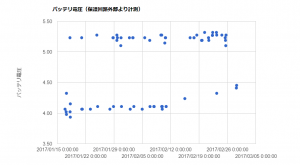筑波大学衛星 ITF-2 「結 2号」について
ITF-2は2017年1月16日に国際宇宙ステーション(ISS)から放出された10cm角の1Uキューブサットです。
2か月経過した2017年3月16日現在,順調に稼働しています。
ITF-2 はアマチュア無線周波数帯において,宇宙無線通信への興味を喚起して
宇宙に興味を持つ人々のネットワークを構築することを主要なミッションとしており
従来の大学衛星で良く用いられるCWビーコン(A1A)や1200bps AFSK(F2D)だけでなく
周波数変調によるモールス(F1A)による電波送信を用いるなどの特徴があり
新聞・雑誌にも多く取り上げられています。
簡便なアンテナと無線設備によって信号受信ができるよう送信出力にはマージンを取り
また,充分な電源容量を確保するために,18650B リチウムイオン電池を用いています。
2か月の運用中の電圧変化を図1に示します。
太陽電池パネルからの発電の無い夜間においては4V強,昼間においては満充電となり
設計通り過充電保護回路が作動し,5V強の太陽電池発電電圧が計測されています
(この状態ではリチウムイオン電池は太陽電池パネルから電気的に切り離されています)。
また,2月下旬以降は,日陰から日照に遷移する際の電圧データが計測され
ほぼ満充電状態と推察される電圧が計測されました。
これらのデータから,充放電は順調に行われており,劣化も見られていないことが確認されました。
電池の温度は加熱装置によって8℃に保たれています。
図1 運用中の電圧変化

